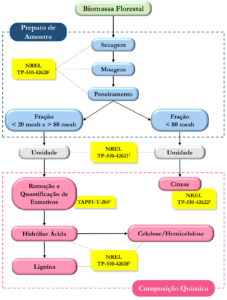Characterization of Forest Biomass
The main chemical components of forest biomass are cellulose, hemicellulose, lignin, as well as ashes and extractives. The procedures for characterization of this type of biomass most used worldwide are TAPPI (Technical Association of the Pulp and Paper Industry) and NREL (National Renewable Energy Laboratory).
The flow chart below illustrates the steps for quantification of the main chemical components of forest biomass following the internationally recognized reference methods.

Initially it is necessary to prepare the biomass received for the characterization analysis of its chemical composition1. The biomass should go through the stages of drying, milling and sieving, as illustrated in the flow chart above.
The drying can be done either in open air or in convection ovens. This step is required in order to reduce the humidity of the biomass and, thus, reduce the chance of microbial proliferation.
Grinding is important to reduce the particle size of the forest biomass, which is usually obtained in the form of shavings, chips, or forest residues. This milling stage is usually performed in a knife mill.
Sieving the biomass for particle size separation is important to standardize the particle size used in each characterization step. Sieves of 20 and 80 mesh are used to separate the biomass into three fractions. The first, the fraction that was retained on the 20 mesh sieve, i.e., with a larger particle size, must be milled again to be used. The second, the fraction that passed through the 20 mesh sieve and was retained on the 80 mesh sieve, is used for the removal and quantification of extractives, as well as the determination of lignin and structural carbohydrates. The third fraction, the finest among them, is the one that has the particles that passed through the 80 mesh sieve. In this fraction the determination of ash2 is performed.
In the fractions used to characterize the chemical composition, the determination of total solids or moisture3 must also be performed, since all analyses must consider the dry mass basis of the sample.
The removal and quantification of extractives in biomass should be performed in the second fraction, i.e., the one that passed through the 20 mesh sieve and was retained on the 80 mesh sieve. The determination of extractives in biomass from wood or forest residues can be performed in several ways, using different solvents4.
From the extractive-free biomass an acid hydrolysis is performed to break the lignocellulosic structure and thus it is possible to quantify the structural carbohydrates and soluble lignin in the hydrolysate. The insoluble lignin is determined in the solid residue fraction obtained after acid hydrolysis5.
Table 1 presents the results of the characterization of forest biomasses used in this project, the eucalyptus and pine residues, performed at the Federal University of Viçosa (UFV).
Table 1: Chemical composition of the forest biomass samples.
Pinus Residues | Eucalyptus | |||
| Average (%) | SD (%) | Average (%) | SD (%) | |
| Total Ashes (%) | 0.3323 | 0.0319 | 0.3298 | 0.0378 |
| Extractives (%) | 1.6970 | 0.1202 | 2.5042 | 0.0960 |
| Insoluble Lignin (%) | 27.7582 | 0.4885 | 27.0245 | 0.9233 |
| Soluble Lignin (%) | 1.4656 | 0.0332 | 1.3390 | 0.0436 |
| Cellulose (%) | 36.9217 | 1.5471 | 47.0142 | 1.4455 |
| Hemicellulose (%) | 11.7222 | 0.1821 | 14.1192 | 0.3789 |
SD: standard deviation.
References
- Hames, R. Ruiz, C. Scarlata, A. Sluiter, J. Sluiter, D. Templeton. Preparation of Samples for Compositional Analysis. Technical Report. NREL/TP-510-42620, 2008.
- Sluiter, B. Hames, R. Ruiz, C. Scarlata, J. Sluiter, D. Templeton. Determination of Ash in Biomass. Technical Report. NREL/TP-510-42622, 2008.
- Sluiter, B. Hames, D. Hyman, C. Payne, R. Ruiz, C. Scarlata, J. Sluiter, D. Templeton, J. Wolfe. Determination of Total Solids in Biomass and Total Dissolved Solids in Liquid Process Samples. Technical Report. NREL/TP-510-42621, 2008.
- Buchanan. Solvent extractives of wood and pulp. TAPPI – T 204 cm-97, 2007.
- Sluiter, B. Hames, R. Ruiz, C. Scarlata, J. Sluiter, D. Templeton, D. Crocker. Determination of Structural Carbohydrates and Lignin in Biomass. Technical Report. NREL/TP-510-42618, 2012.
